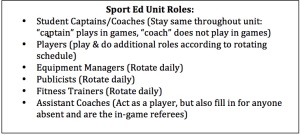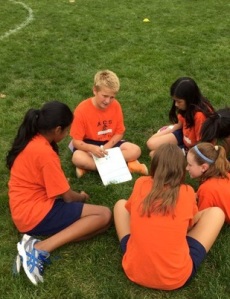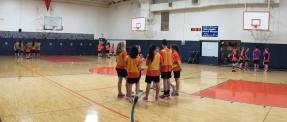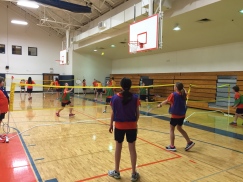This blog post by Adam Metcalf was a feature on the Gopher P.E. Blog
“The best way to learn is to do. The worst way to teach is to talk.” –Paul Halmos
We all know that student-centered, authentic learning experiences are crucial for cultivating the type of learners who will be best prepared for success in the modern world. The incessant battle for weak attention spans has unearthed how incredibly important it is to design learning experiences that allow for student choice. At the same time, we must foster the development of social interdependence in a safe, supportive environment where gaining perspective through a shared journey is the objective. Alas, knowing that something is important and figuring out a practical way to do it is the ongoing challenge of our profession. Taking risks, giving up control, and stepping outside of our comfort zones as teachers can be daunting.
My physical education department has been using a Sport Ed/TGfU hybrid model for nine years in our middle school curriculum (Grades 5-8). Although it may seem intimidating, the shift away from the traditional sport units and instructional methods to a student-centered approach has been more fulfilling than we could have ever predicted! In this approach, the teacher acts as the facilitator for learning rather than the traditional “sage on stage.” We have seen amazing engagement and growth in our students through adapting and combining elements from the Sport Education and Teaching Games for Understanding (TGfU) instructional models.
While an “event driven” unit can be exciting and memorable, an overcomplicated unit can result in an enormous amount of planning and management; this may lead to teacher burnout and a decrease in student engagement. We have found that adapting some simple elements from the Sport Ed model and using the themes and structure of the TGfU model can help provide a framework for engaging and repeatable units without teacher burnout. We have tried many variations and continue to tweak the unit structure, but have found the most success using the basic guidelines below:
Unit Planning:
Begin your year establishing expectations, building relationships, cooperative skills, etc. Then plan and sequence your units according to the TGfU Game Categories:
Invasion Games (Soccer, Rugby, Basketball, Ultimate, Floor Hockey, etc.) will be the most prevalent sport category. Begin with a sport unit that is simple and/or one with which students are familiar. Skills and strategies will transfer from one sport to the next (i.e., maintaining possession and creating space in soccer will also be applicable in basketball). Grouping these sports together will create a deeper understanding and an increased familiarity with how to react to and solve the in-game problems and situations.
Sequencing Net/Wall Games during the winter months work well with the indoor space and equipment available at our school (Volleyball, Badminton, Pickleball, etc.).
As the weather warms up in the Spring, we prefer to finish the school year with Target (Golf, Archery, Bowling, etc.) and Striking/Fielding Games (Kickball, Softball, Cricket, etc.).
Each sport unit (within the TGfU category) is typically eight to twelve 45-minute sessions. Our students have daily P.E. so each unit spans approximately 3 weeks. We usually complete 6-8 sport units per school year:
2-4 sessions of preseason practice
3-4 sessions of regular season games (team records count toward tournament seeding)
3-4 sessions of post season tournament (usually double elimination)
Keep It Simple
Limit the number of roles and responsibilities. In our units, everybody is a player and some people have additional roles. Each team has a coach (who volunteers prior to the start of the unit). Once balanced teams are determined, all members meet to sign the Team Contract/ Fair Play Agreement as well as determine who will take on the additional responsibilities: assistant coach, equipment manager, fitness trainer, publicist. By structuring simplified Sport Ed units, repeating the model will allow several students the opportunity to experience the various roles.
Facilitate Learning
Rather than giving the students skills and drills, we allow them to come up with their own practice plans. We encourage them to take the focus of the day and play a modified game that will allow players to develop an understanding within a dynamic, fun setting. Using the TGfU model structure, we encourage and assist coaches with implementing small-sided games to emphasize the strategies and skills needed to achieve success. When we are focused on offensive strategies, modifying the number of defenders and/or restricting movement will allow for more meaningful practice on the offensive side.
Example: Preseason Learning Outcome: Maintain possession by creating space using pivots, fakes, and jab steps.
Scoring: Offensive players score a point every time they complete 3 consecutive passes within the prescribed boundary. Take turns playing offensive and defensive positions where the defensive team is outnumbered (i.e. 2 vs 1, 3 vs 2, 4 vs 2, etc.)
Ask Lots of Questions
The authentic nature of this format can heighten the potential for group dynamics to get messy. It is important for the teacher to make sure that a safe classroom culture is paramount. Giving up control to the students is undoubtedly difficult, but this is the best way for them to learn. Your students need to know that you are there to support them and need you to remain firm and consistent with what is expected from every member of the class. If a practice or game isn’t going or didn’t go well, ask questions of the coaches that will advance a more reflective, open mindset. Allow students to express themselves in daily class discussions, or in private as needed. Be willing to make adjustments based on the feedback and needs of the class.
The engagement and enthusiasm fostered through this model is unparalleled. We have also found that once students have experienced autonomy and authenticity of this type of unit (i.e., peer-lead activities and the use of teams that stay together through a preseason, regular season, and postseason), they overwhelmingly prefer a “Sport Ed” unit to a traditional unit. I highly recommend giving it a try and seeing for yourself!
For a more extensive look into TGfU and Sport Education hybrid units, check out a recording of my webinar, Maximize Engagement: Sport Ed. & TGfU Hybrid Units.







